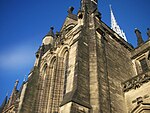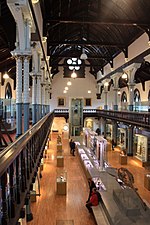Cameronians War Memorial
1924 establishments in ScotlandBuildings and structures completed in 1924Category B listed buildings in GlasgowListed monuments and memorials in ScotlandMonuments and memorials in Glasgow ... and 3 more
Use British English from March 2017World War II memorials in ScotlandWorld War I memorials in Scotland

The Cameronians War Memorial is a war memorial in Kelvingrove Park in the west of Glasgow, Scotland, to the north of Kelvingrove Art Gallery and Museum. It commemorates the service of the Cameronians (Scottish Rifles) regiment in the First and Second World Wars. The memorial includes a bronze sculpture representing a machine gun emplacement, with three human figures. It became a Category B listed building in 1988.
Excerpt from the Wikipedia article Cameronians War Memorial (License: CC BY-SA 3.0, Authors, Images).Cameronians War Memorial
Argyle Street, Glasgow Kelvinhaugh
Geographical coordinates (GPS) Address Nearby Places Show on map
Geographical coordinates (GPS)
| Latitude | Longitude |
|---|---|
| N 55.86939 ° | E -4.2922 ° |
Address
Argyle Street
G3 8AN Glasgow, Kelvinhaugh
Scotland, United Kingdom
Open on Google Maps








